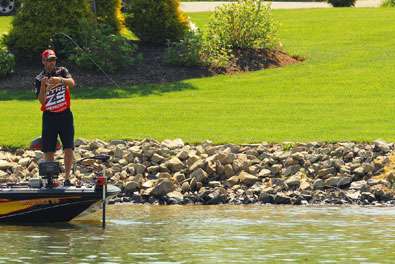
Power fishing.It's a strategy most Bassmaster Elite pros employ, but no one is more devoted to its principles — nor has anyone been as successful with it — as Kevin VanDam.Many anglers define power fishing as simply using heavy line, big baits and fishing heavy cover. VanDam takes it further, adding elements of time management and efficiency with a broader range of tools and tackle."It's not simply a matter of fishing spinnerbaits and crankbaits or flipping jigs and plastics into heavy cover," he insists. "It's about maximizing your time with the lures and techniques required to catch fish under current conditions."And who can argue with his success? The four-time Toyota Tundra Bassmaster Angler of Year continues to roll up Bassmaster victories and Top 10 finishes with a style of fishing unparalleled by any other angler on tour."Every time I go out, my goal is to cover as much water as possible while remaining highly efficient," he describes. "Anyone can fish fast, but can they do it efficiently?"Power fishing is particularly important to VanDam during practice and remains a work-in-progress throughout the tournament. Because of his style of fishing, he says two and a half days of practice is more than enough for him to dial into where and how he will fish, knowing he will be tweaking it throughout the competition days."I usually find most of my patterns and areas I want to fish the first day of practice, then expand upon them the second day," he says. "The third day is spent looking for back-ups."
Power fishing isn't just for those days when the bass are easily patterned and aggressive. This spring was a prime example when he got off to a great start on the Elite Series Tournament Trail.We fish multi-day events, so when weather and fishing conditions change as dramatically as they did this spring, daily adjustments were critical," he says. "By covering a lot of water and using a multitude of techniques quickly, I was able to adapt faster than guys who are more methodical."VanDam's lure selection is predicated on whether the fish want a lure fished horizontally or vertically, which he determines by assessing the water clarity, temperature, type of lake, cover and the seasonal pattern.
"It's not so much the lure, but what you need to do with it and how you must work it," he adds. "Once I determine that, I began the process of fine tuning the lure choice."The Michigan pro admits that his style has its drawbacks. He may not be as thorough as other anglers, thus opportunities to trigger inactive fish are reduced somewhat."I'm not trying to catch every single fish off a spot," he says. "I'm running the percentages, hitting 10 spots in three hours, fishing for the most aggressive fish on each of those spots. In my mind, that's better than fishing one spot for three hours trying to catch every fish on it.And while power fishing has certainly worked for him in pro tournaments, he believes it can work for weekend or recreational anglers, too.Those guys have a short window to fish, so they have to be even more efficient with their time," VanDam says. "Power fishing is a good way to find fish in a hurry."One exception is on smaller lakes with fewer options. VanDam says anglers can be more methodical on lakes without a lot of points, creeks, cover or changes in structure. But on larger lakes where multiple patterns may be in play, a run-and-gun approach exposes you to a variety of possibilities and helps you dial in the very best pattern."By moving around, I fish different spots and can more easily recognize subtle changes in conditions that I wouldn't notice while sitting on one hole," he explains.Therein lies an often overlooked, yet integral part of his strategy. He's very detail-oriented, looking for the slightest clues the fish reveal and using them to build a more definitive pattern.I don't have to catch a fish to learn a pattern," he explains. "If I have a fish follow, strike, and miss or see a lot of bait in an area where the fish should be, it helps me refine the pattern. But I can't do that if I'm fishing one spot and trying to vacuum everything that's there."
He is always studying the mood of the fish. If it strikes short on a spinnerbait, that tells him he had the fish interested but not fully committed. If they crush it, he knows he's nailed it."You can't accept a strike on a given lure as being the exact pattern," he insists. "You have to strive to get closer to the exact lure, exact retrieve, and pattern that will produce the best and most strikes at that given moment. While some anglers believe power tactics and finesse fishing are polar opposites, VanDam disagrees."There's not a lure I wouldn't use, including tubes, shaky head worms and drop shots," he offers. "It's about how you present it efficiently and effectively."VanDam says the system dictates making precise casts to specific spots. You rarely see him working a lure all the way back to the boat."I see guys make long casts with a shaky worm, then work every inch back to the boat and do it over and over again," he says. "They're spending a lot of time with their lures in dead water, and I can't do that."VanDam says experience and maturity have made him a better power fisherman. In his early years, he simply ran around and fished fast all the time.
Now, once I figure out an area and have caught a fish off it, I may go back through there with a slower finesse presentation, like a football jig or shaky head," he explained. "But even at that, I may discover I can opt for a heavier jighead, fish faster and still get as many bites."




